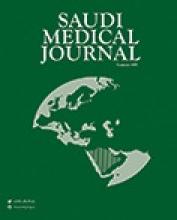Abstract
OBJECTIVE: A large variety of disorders can lead to lymphadenopathy. It is important and beneficial to patient management to rapidly differentiate between benign and malignant causes. The objective of the study is to identify factors predicting nodal malignancy from readily available clinical data.
METHODS: A retrospective study was carried out on patients admitted to Riyadh Medical Complex, Riyadh, Kingdom of Saudi Arabia between April 1996 and March 2000 with lymphadenopathy, who underwent lymph node biopsy.
RESULTS: Univariate analysis suggests 6 variables (age, sex, the presence of other physical signs, abnormal complete blood count, abnormal liver function test and negative Mantoux test) to have independent association with nodal malignancy. The multivariate logistic regression model revealed patients aged more than 40 years, males, generalized lymphadenopathy, presence of other physical signs, abnormal liver function tests and negative Mantoux test to be statistically significantly associated with nodal malignancy (p>0.05).
CONCLUSION: The present logistic model can be useful in predicting nodal malignancy using routinely collected clinical data.
- Copyright: © Saudi Medical Journal
This is an open-access article distributed under the terms of the Creative Commons Attribution-Noncommercial-Share Alike 3.0 Unported, which permits unrestricted use, distribution, and reproduction in any medium, provided the original work is properly cited.






